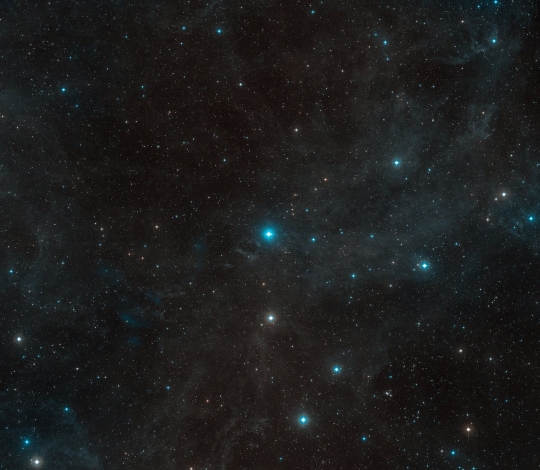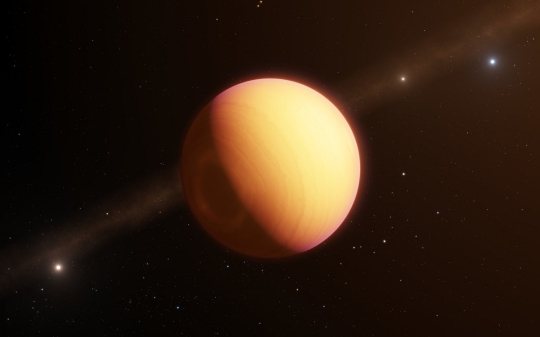A method for enhanced exoplanet investigation takes center stage today as we look at the GRAVITY instrument, a near-infrared tool aided by adaptive optics that brings new precision to exoplanet imaging. In operation at the European Southern Observatory’s Very Large Telescope Interferometer (VLTI) at Paranal Observatory in Chile, GRAVITY works with the combined light of multiple telescopes to produce what would otherwise take a single telescope with a mirror diameter of 100 meters to equal. The early demonstrator target is exoplanet HR 8799e.
The method at work is interferometry, and here we are applying it to a ‘super Jupiter,’ more massive and much younger (at 30 million years) than any planet in our Solar System. The GRAVITY observations of this target mark the first time that optical interferometry has been used to study an exoplanet at this level of precision, producing a highly detailed spectrum. The planet is part of a 5-planet system some 130 light years away, all 5 of the planets being gas giants between 5 and 10 times the mass of Jupiter.

Image: This wide-field image shows the surroundings of the young star HR 8799 in the constellation of Pegasus. This picture was created from material forming part of the Digitized Sky Survey 2. Credit: ESO/Digitized Sky Survey 2. Acknowledgement: Davide de Martin.
The high resolution images that resulted from this work show what we can expect from optical interferometry going forward. We now know the distance between HR8799e and its star with 10 times the accuracy of previous estimates, which in turn helps to refine the planet’s orbit, one that appears to be slightly inclined compared to the orbital plane of its four companions.
That high-grade spectrum has spoken volumes about the composition of the planet’s atmosphere, says team leader Sylvestre Lacour (Observatoire de Paris and the Max Planck Institute for Extraterrestrial Physics):
“Our analysis showed that HR8799e has an atmosphere containing far more carbon monoxide than methane — something not expected from equilibrium chemistry. We can best explain this surprising result with high vertical winds within the atmosphere preventing the carbon monoxide from reacting with hydrogen to form methane.”
Also present here are clouds of iron and silicate dust, all suggestive of violent storms, as convection causes the dust to rise and then descend into the interior. We’re seeing a giant planet in its turbulent infancy. And what an impressive demonstration of interferometry’s ability to separate star and, in this case, a very close planet, with a result that the European Southern Observatory considers much cleaner than what could be achieved with a coronagraph that would mask out the light of the star.

Image: Exoplanet HR 8799e has been analyzed spectroscopically separate from the parent star HR 8799 using the new technique (artistic impression). Credit: © ESO/Luis Calçada.
We’ll be using analyses of planetary atmospheres to look for biosignatures one day on cooler and more clement worlds. In the interim, astronomers plan to continue the investigation of the HR8799e system, allowing so complete an analysis of the planet’s orbit that it will be used to reveal the mutual gravitational interactions of the giant planets as well as the influence of the central star. That, in turn, takes us to accurate estimates of the planetary masses.
And these excerpts from the paper are notable. In the first, ‘Kmag’ refers to ‘K magnitude,’ the magnitude of the star about which the extrasolar planet orbits as viewed through a specific filter at near-infrared wavelengths, in this case between 2.0 and 2.4 ?m. GRAVITY operates within the K band:
The interferometric technique brings unique possibilities to characterize exoplanets. With the technique described here, any planet with K ? 19, ?Kmag ? 11, and separation ? 100 mas is, in theory, observable with GRAVITY. The numbers are still to be refined, but it would mean that GRAVITY could observe most of the known imaged planets, and maybe in the near future planets detected by radial velocity [italics mine].
And this:
…the idea that an interferometer can resolve the surface of exoplanets, giving radius and resolving clouds patchiness, is now becoming more plausible. However, it would require an interferometer with baselines on the order of 10 km. This could be a goal for ESO after ELT construction.
The paper is Lacour et al., “First direct detection of an exoplanet by optical interferometry,” in Astronomy and Astrophysics, Vol. 623 (March 2019), L11 (abstract / preprint).



5 planets? Have I missed something? I thought there were ‘only’ 4!
(pretty cool [hot] results though…)
P
This is another instance where an abundance of carbon monoxide (CO) has been noted in jovian mass planet. Back about forty or so years ago, the non-equilibrium abundance was noted in Jupiter’s atmosphere, and at least one other exoplanet instance was cited here on Centauri Dreams in the last few months. At the very least, since this is a very young planet and system ( 30 million years old estimate), I would not suggest that there is an alien LA below the upper clouds and some atmospheric pressure above a bar. But there does appear to be an un-modeled mechanism for either producing all this CO or else circulating it up to the higher atmospheric levels through a convection process. And evidently it is a commonplace among planets of this size.
All that CO need not be produced by the planet; it could be left over from the planet’s formation since it is part of a young system. After all, “carbon monoxide is the second-most common molecule in the interstellar medium, after molecular hydrogen”, per wikipedia. Maybe it’s even still being accreted onto the planet.
Bruce D. Mayfield,
Considering the abundance, as you said, there is another side of the coin. In addition, there are considerations such as equilibrium values at temperature, reactivity or stability. What caused note with the case of Jupiter was that at detectable altitude and surrounding temperature, CO seemed too abundant – and it was presumed to be indicative of an up-welling of atmospheric currents from a region of about 1000 or more degrees Kelvin. In the absence of free oxygen, I don’t know what it would react with in a low temperature atmosphere. But I have not heard accounts of its abundance in Saturn or the other Outer Planets.
Eric Mamajek posted this on Twitter 15 hours ago: Post-Pong Pre-Pacman Space Invaders? Better be bigger than TRAPPIST-1 given the hype… Ryan Rubenzahl replying to NSF “seemingly empty image has three images hidden within…” Could this be planets orbiting either Alpha Centauri A or Alpha Centauri B from the VLT Sphere/VISR imaging campaign we talked about last year, phase curve images of Proxima b by Sphere/ESPRESSO, or even possibly an OPTICAL image of Proxima b by the VLT Sphere/Zimpol/high amplitude pupil mask combination?
Of course this could also be about the black hole “image” to be anounced tomorrow, but I doubt it, because of the TRAPPIST-1 analogy. After thinking about this overnight I came up with a more plausible scenario. The key point here is the three images. I posted a comment on this website last year about possibly obtaining a very low scientific value but great HISTORICAL value optical image of Proxima b at around this time of year using a high amplitude pupil mask on the SPHERE/ZIMPOL instrument package on the Very Large Telescope. The authors of this putative(i.e., NOT scheduled)imaging campaign suggested that before such a campaign be initiated, the package should be TESTED OUT on the Gliese 876 system. If this was done, the “three tiny images” could be that of Gliese 876b, Gliese 876c, and Gliese 876e(Gliese 876d is too close to Gliese 876 to be imaged at this time).